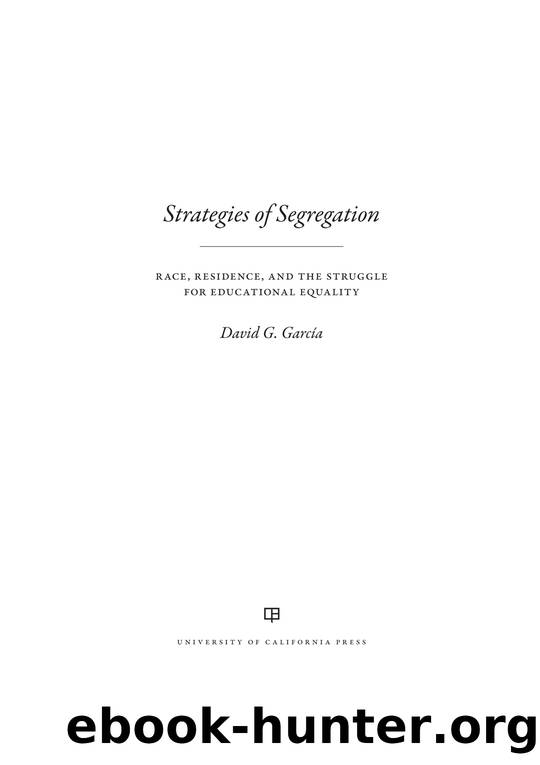Strategies of Segregation by David G. García

Author:David G. García
Language: eng
Format: epub
ISBN: 9780520296862
Publisher: University of California Press
AFFIANTS FOR AND AGAINST BUSING
If the hopes which have arisen in the minority community as a result of finally attaining the first step toward justice in Oxnard (i.e.) equal schooling are to be dashed at this juncture, feelings of resentment, frustrations, anger and hatred may more sharply divide this community than the Southern Pacific Railroad Tracks and the four-lane boulevard which separates affluent homes in the white community from the crowded and neglected projects and multi-family dwellings in the Barrio.
âFRED JONES, PRESIDENT, NAACP, 1971145
In addition to asserting important legal arguments, Soria carried forward a common cause between Mexican Americans and Blacks. Notably, however, none of the groups who had mobilized collectively against school and residential segregation in the 1960s (e.g., CSO, MAPA, NAACP) officially participated as an organization in the Soria case. Still, footprints of these and other organizations who advocated for justice in Oxnard appeared in the facts presented by the plaintiffs, the legal rationales applied, and the specific considerations requested in fashioning a remedy. Fred (Frederick C.) Jonesâs affidavit, as president of the NAACPâsubmitted as part of the plaintiffsâ response to the petition by the board to stay busing one week before the school year started in 1971âdemonstrated multiple continuities in community advocacy networks over time in Oxnard. Ironically, none of these affiants were Mexican American. Jones and nine other Black and White parents, teachers, and community members presented the perspectives of west-side residents who opposed the stay and shared a commitment to integration. For example, William and Margaret Thrasher signed affidavits assuring the court that despite the intense opposition expressed by parents in the spring, they and many families on the west side were ready to participate in the integration program.146 Margaret explained that a stay âwould cause much confusion and unnecessary expense to the elementary district, as well as causing a reversal in the mellowing mood of the community.â147 Barbara Gardner, who taught at Harrington, noted concern that the stay was another example of âthe students in the Oxnard Elementary School District . . . being victimized by School Board attempts to retain the vestige of a segregated school system in Oxnard.â148
In contrast, the board membersâ affiants, such as trustee Mason, claimed the school district was the victim, unfairly âsaddled with the burden of alleviating conditions that they did not condone, but actively sought to avoid.â149 Trustees Rachel MurguÃa Wong and Mary O. Davis specifically expressed support for integration but stood with trustees Tinklepaugh, Mason, and Mytinger in opposition to busing.150 Davis claimed there would be âminimal, if any, objection to one-way busing,â from the east side to the west side and expressed her feeling that the court order âindicts the school district and saddles it with the responsibility of rectifying poor urban planning,â which she asserted, was not the fault of the school officials.151 She attempted to reassure the court that while âthere are segregationists and racists in Oxnard,â even âfirm believers in integration and equal opportunityâ stood adamantly against two-way busing.152
Despite the board membersâ
Download
This site does not store any files on its server. We only index and link to content provided by other sites. Please contact the content providers to delete copyright contents if any and email us, we'll remove relevant links or contents immediately.
Nudge - Improving Decisions about Health, Wealth, and Happiness by Thaler Sunstein(6651)
iGen by Jean M. Twenge(4711)
The Fire Next Time by James Baldwin(4358)
Adulting by Kelly Williams Brown(3690)
The Sports Rules Book by Human Kinetics(3605)
The Hacking of the American Mind by Robert H. Lustig(3592)
The Ethical Slut by Janet W. Hardy(3524)
Captivate by Vanessa Van Edwards(3312)
Mummy Knew by Lisa James(3177)
In a Sunburned Country by Bill Bryson(2959)
The Worm at the Core by Sheldon Solomon(2936)
Ants Among Elephants by Sujatha Gidla(2933)
Suicide: A Study in Sociology by Emile Durkheim(2617)
The Slow Fix: Solve Problems, Work Smarter, and Live Better In a World Addicted to Speed by Carl Honore(2581)
Humans of New York by Brandon Stanton(2385)
Handbook of Forensic Sociology and Psychology by Stephen J. Morewitz & Mark L. Goldstein(2383)
Blackwell Companion to Sociology, The by Judith R. Blau(2322)
The Happy Hooker by Xaviera Hollander(2278)
Outliers by Malcolm Gladwell(2268)
